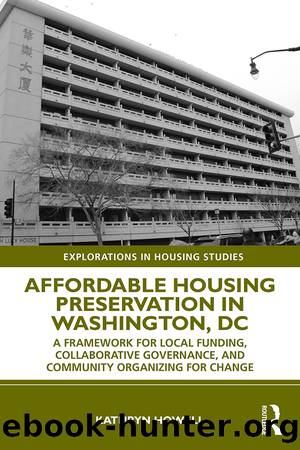Affordable Housing Preservation in Washington, DC by Kathryn Howell

Author:Kathryn Howell [Howell, Kathryn]
Language: eng
Format: epub
Tags: Social Science, Sociology, Urban, Human Geography
ISBN: 9781000383386
Google: dfUlEAAAQBAJ
Publisher: Routledge
Published: 2021-05-16T05:07:17+00:00
The Roots of DC Policy: The City and the Federal Government
Before digging into the debates in the District, itâs important to lay the groundwork for the relationship between the federal government and the District government. Much is written about the role of the federal government in Washington11, but depending on where in the District you work, the federal governmentâs role in daily life is a big shrug since Home Rule was granted in 1974, as a way of asserting independence in a fundamentally unequal system12. Yet in the bigger picture, Washington has limited control over its own fate. Like many cities, the state â in this case the federal government â can preempt legislation made by the District. But, unlike other cities, District residents have no vote in the body that preempts the legislation. Those representatives who serve on the Committee for the District of Columbia have a 30-day review of all legislation, including the budget, passed by the DC Council. While they often pass on the opportunity to review or veto legislation, issues of national importance â needle exchanges, marijuana legalization, abortion, for example â create opportunities for legislators assigned to this committee that otherwise offers little to deliver to their constituents the chance to prove their credentials to their voters. At the same time, being in the backyard of the federal government creates both risks and rewards. As Chapter 2 suggests, having Congress and the US Department of Housing and Urban Development (HUD) nearby meant that the District avoided the moratorium on new HUD contracts and that Congress was watching Urban Renewalâs implementation and the neighborhood reaction to it.
Being in Washington, DC creates another challenge and opportunity. As a central spot for political power and organizing, DC attracts new residents as government, nonprofits, lobbying or other issue related to government shifts. In the 1960s and 1970s, this meant the District welcomed activists from the Civil Rights Movement, voter mobilization drives, womenâs rights activism, legal activism and community organizing who saw the possibility for a more equitable city. These activists became the base of the Districtâs first elected council in 1975. This trend has been critical since the Districtâs founding and has resulted in a broad range of native Washingtonians over time â both those focused on emancipation and Black and community-based power and those focused on the bureaucracy and political functions of the District. However, as times change, so have new residents coming to the District. The national trend that has fueled the growth of cities more broadly â including investment, demographic shifts in family formation and household preferences â has meant that the growth in population in Washington, like many coastal cities, has come from white, upwardly mobile households with little connection to the ideals of Black and low-income empowerment or collective, rights-based policy.
Outside of the federal influence, Washington, DC sits in a unique spot of having the functions of both the state and a local government. This is particularly important in housing and community development policy and land use.
Download
This site does not store any files on its server. We only index and link to content provided by other sites. Please contact the content providers to delete copyright contents if any and email us, we'll remove relevant links or contents immediately.
Kathy Andrews Collection by Kathy Andrews(11737)
The remains of the day by Kazuo Ishiguro(8828)
Paper Towns by Green John(5092)
Spare by Prince Harry The Duke of Sussex(5077)
Industrial Automation from Scratch: A hands-on guide to using sensors, actuators, PLCs, HMIs, and SCADA to automate industrial processes by Olushola Akande(4994)
The Body: A Guide for Occupants by Bill Bryson(4976)
Machine Learning at Scale with H2O by Gregory Keys | David Whiting(4193)
Be in a Treehouse by Pete Nelson(3954)
Never by Ken Follett(3799)
Harry Potter and the Goblet Of Fire by J.K. Rowling(3776)
Goodbye Paradise(3729)
Into Thin Air by Jon Krakauer(3314)
The Remains of the Day by Kazuo Ishiguro(3296)
The Cellar by Natasha Preston(3264)
The Genius of Japanese Carpentry by Azby Brown(3228)
Fairy Tale by Stephen King(3221)
120 Days of Sodom by Marquis de Sade(3184)
Drawing Shortcuts: Developing Quick Drawing Skills Using Today's Technology by Leggitt Jim(2998)
The Man Who Died Twice by Richard Osman(2998)
